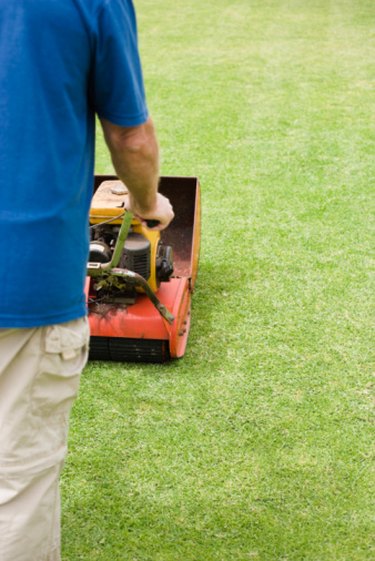
Dallisgrass (Paspalum dilatatum) is an evergreen, perennial grass native to Uruguay and Argentina. This tufted, broad-leafed grass reseeds itself generously and is considered a pest in most lawns. As with crabgrass, which dallisgrass resembles, prevention is the best method of weed control. Thick, healthy lawns block out the sunlight dallisgrass craves, preventing the weed from growing. Although somewhat difficult to control once it appears in the yard, a determined homeowner can eventually get rid of unattractive dallisgrass clumps with selective herbicides.
Identification
Video of the Day
Dallisgrass spreads through seed distribution and by rhizomes. Unchecked, dallisgrass reproduces multiple times to form a thick, clumpy mass. The leaves are about 1/2 inch wide and grow up to 10 inches long, making them easily distinguishable from thinner, desirable turf grasses. Dallisgrass often has hairy-looking leaf sheaths at the base of the clump. Flower stalks can grow as tall as 65 inches and each flower has up to 10 spikelets with two rows of seeds each. The spikelets are pale green to purple.
Video of the Day
Pre-Emergent Herbicides on Lawns
Pre-emergent herbicides stop germinating seeds from growing into weeds. Pre-emergent herbicides must be applied before the seeds begin to germinate in the spring, before the soil temperature reaches 55 degrees F for two to three days. Look for herbicides formulated to control crabgrass. A pre-emergent herbicide with a combination of benefin and oryzalin, dithiopyr or prodiamine should be effective in controlling dallisgrass seed germination. Follow label directions to apply the herbicide. Water the lawn to a depth of about 1/2 inch after applying the herbicide so it will reach as many dallisgrass seeds as possible.
Post-Emergent Herbicides on Lawns
Some dallisgrass seeds will almost certainly manage to grow into weeds despite the use of pre-emergent herbicides. Once dallisgrass is actively growing in the lawn, use a post-emergent herbicide to kill it. Herbicides containing MSMA or CMA applied to the dallisgrass clumps every three weeks should kill the dallisgrass without harming your lawn. Many herbicides are inappropriate for use on certain grasses, so check the label and be sure you know what kind of grass you have before applying any herbicide. Do not apply post-emergent herbicides to grass that is stressed, such as during unusually hot or dry weather. Let the grass and the dallisgrass grow unchecked for a couple of weeks before the first application of herbicide and do not water the lawn afterward. Post-emergent herbicides that control broadleaf weeds like dallisgrass are generally inappropriate for St. Augustine lawns.
Herbicides for Other Areas
If dallisgrass pops up in your flower garden, between hedges or anywhere else but the lawn, consider using glyphosphate. Although glyphosphate is a non-selective herbicide, the product is widely available in a spray bottle that provides fine control over the spray. Spray the glyphosphate only on the dallisgrass when the weed is flowering, but before it has time to produce seeds, and the herbicide will not affect nearby plants.
- University of California Davis; Dallisgrass; M. LeStrange, et al.; July 2008
- North Carolina State University; Dallisgrass; Fred Yelverton, et al.; July 2008
- National Information System of the Regional Integrated Pest Management Centers; Pest Management Strategic Plan for Turfgrass in the Southern United States; Gretchen V. Pettis, PhD, et al.
- NC State University; Strategies for Turfgrass Weed Control; Fred Yelverton; February 2001